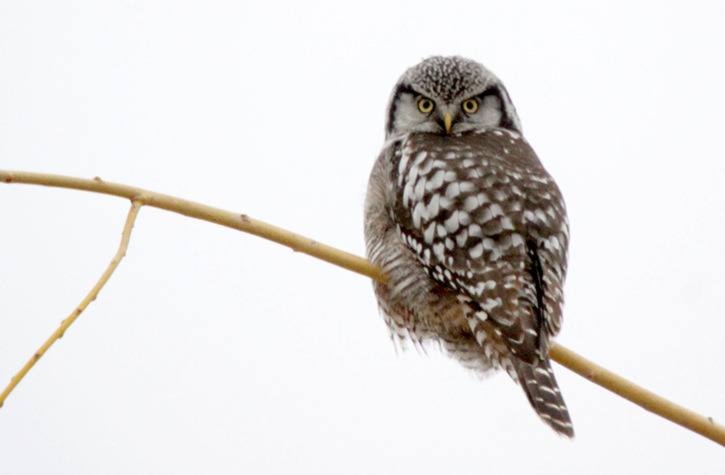One very frosty morning in January, I was on a snoop for the common snipe. Now, if serious birders were out looking for them in the dead of winter or even on the Christmas Bird Count, if they found any at all it wouldn’t likely be more than one or two. Snipes nest all over the valley, in marshes, meadowlands, swamps, bogs and along small watercourses. However, in late fall. when available food diminishes with the closing over of waterways under a firm layer of ice, someone looking for that long-billed bird of the fen would be hard pressed to find one.
So, the trees were covered with heavy hoarfrost and, while the sun was still coming up from behind the mountain at mid-morning, the snow crunched under my feet and my breath hung heavy in the air. Where were those long-legged snipes or were there even any here? I avoided approaching the brook’s bit of open water for fear of startling a bird into a sudden flight to a place out of sight.
With binoculars, I began searching the area from the left, working upstream to the right. I didn’t find a bird. Every little tuft of dead brown grass looked like a snipe. That was with fogged up binoculars. I thought I had better start again and recheck every clump of grass. Yes, there was one standing in the freezing water at the edge of some frozen protruding moss and mud, topped with a tuft of grass. Then, not far away, I spotted a second and a third standing motionless like a tuft of grass in dead air. The continued search was not productive, but that doesn’t mean these were alone. Snipes are very camouflaged in summer standing in the grass of a vibrant marsh, but these were nearly invisible. Now, just because I don’t see something doesn’t mean it isn’t there!
Another unusual sighting here in winter is a western meadowlark. Again, on a frosty morning in January, the look is on. It means a trip to the cattle feeding areas or small cattle sheds. Let’s look around the feet of the cattle and try to locate one amongst those dozens of blackbirds. I have never seen a meadowlark on the back of a bovine; however, let’s check the backs of the cattle anyway, where one or two blackbirds may be perching. Another place to check is around the little shelters. They have been occasionally seen roosting on beams just under the shed’s roof. The last place I saw one in winter was on the flats picking up gravel along the highway’s edge. Other birds also find road edges a source of grit for the gizzard when other gravel spots are snow-covered.
Both the meadowlark and the common snipe are summer residents here; however, another rare winter bird resident or visitor, is the northern hawk-owl. In 40 years here in the valley, I have observed about as many hawk-owls as I have snipes or meadowlarks, totals of which have been countable on one hand.
I remember one cold, windy, wintry day, a little jaunt on Nick’s Island North Road. There were quite a number of large willow trees between the river and the road, and the wind was blowing so hard the smaller branches were vigorously waving up and down (and I was waving from side to side). On one branch was a hawk-owl, leaning into the wind and appearing to be hanging on for dear life. Of course, that is humanly speaking. For the hawk-owl, this was probably business as usual, considering what it is used to. Anyway, a hawk-owl has been regularly seen this winter in these parts and hanging out around town where, like many birds, food and shelter are available. The hawk-owl’s main menu is mice.
Hawk-owls, something like pygmy owls but much larger, have a longish, narrow tail, which gives them a falcon-like appearance. That gives them a length of up to 14 inches. That would be a little longer than a Steller’s jay and a little shorter than a crow. Having a barred breast, it is a “barred owl” but not a barred owl. I guess it is more of an owl than a hawk because, in the name, “hawk” appears before owl. Perhaps, somewhere in the world there is an “owl-hawk”. (Enough of that.) The tail bobbing reminds me of a pygmy owl.
Hawk-owls hail from Alaska and mid-northern Canada and rarely come and are seen this far south. I guess, though, if there were more people watching for them, a lot more would be observed. There is a lot out there, much more than we imagine or can imagine. We, except for a few of you I know, spend too much time inside rather than outside, and we miss the best and real show. Some of us have little control over that and may be limited to enjoying what’s out there through the window. With others, it is otherwise.
Either way, referring back to our last meeting in Out There, “We are what we eat,” but also, “We are what we think.” Wholesome, plant-based intake (being a first-order consumer) enhances one’s health. Non-self-serving thoughts, thinking and practices, keeping others in mind, also enhance one’s health and well-being. So, keep on making better and better choices!
Ed McMackin is a biologist by profession but a naturalist and hiker by nature. He can be reached at 250-866-5747.
